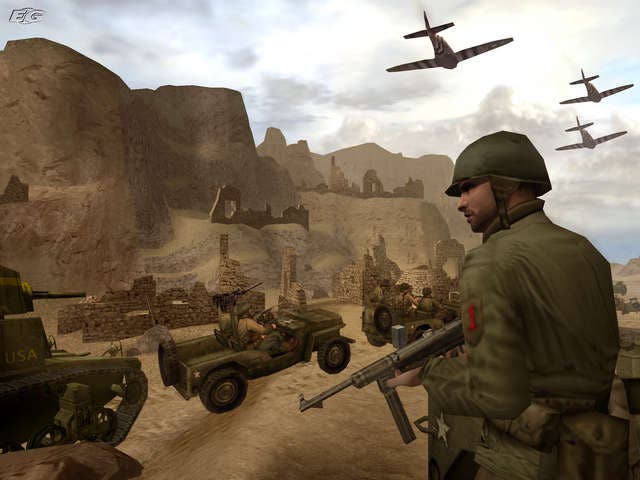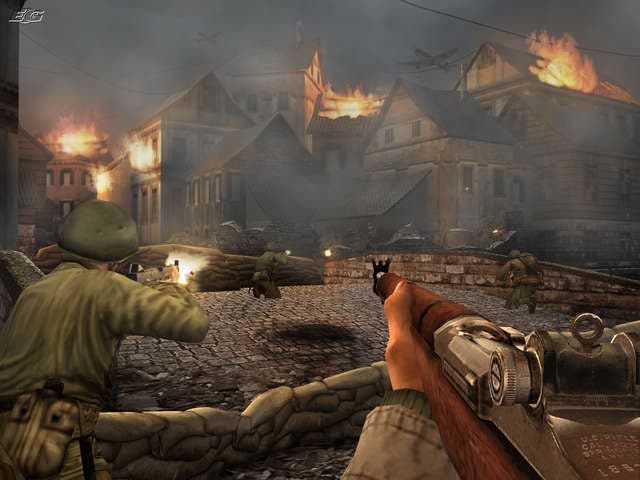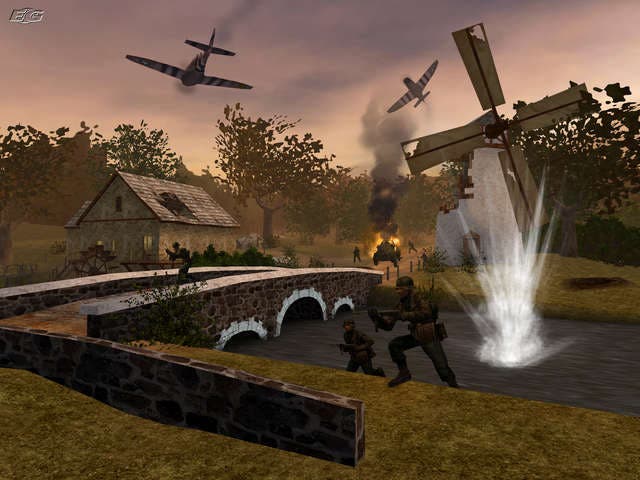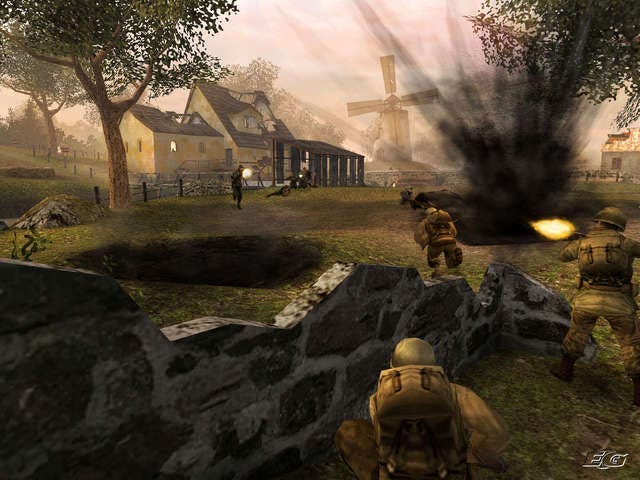Call of Duty 2: Big Red One
Walker reports from the front line on Treyarch's latest.
Being in the middle of Poland, hundreds of miles from the nearest town, having reached where we are by an hour’s violent shaking in a twelve-seater bi-plane, is a peculiar way to see a game. Being ambushed by German officers in the middle of the woods, while on the way to visit Hitler’s Camp Wolf on the back of a WWII jeep, is even stranger. But this was how we were introduced to Call of Duty: Big Red One. It could have been hideous. It could have been a nasty, distasteful PR stunt, pissing on the history of where we were, and what the games were recalling. It’s not quite clear how, but somehow this wasn’t the case. Somehow, it was respectful, educational, and affecting. Which, in many ways, reflects the games it was intended to promote.
The PC’s Call of Duty was an astonishing first-person shooter, built with an orchestral majesty. It understood the crashing cymbals as well as it understood the quietest flutes. It’s a big act to follow. Especially if you’re performing that act on a group of consoles reaching the end of their lives, the bigger, more powerful machines only months away. And while Call of Duty 2 utilises the awesome potential powers of the PC’s multicore processors and the Xbox 360’s triple processing prowess, Call of Duty 2: Big Red One (confusing titles, we realise) would surely be a generation behind?
So it was, as we sat in one of the few Nazi bunkers that hadn’t been blown apart, we were to stare in disbelief at the images appearing on the giant screens in front of us. (This was after getting over the slightly more disorientating disbelief that we were sat in a Nazi bunker, surrounded by German officers, watching giant widescreen monitors showing us videogames). Was this really the PS2, we asked one another, or was this the 360 game? That’s some accolade.

And not one new to developer Treyarch’s creative director, Christian Busic. “At E3 this year, we had two big flat-panel monitors up, and I got so many questions. ‘Hey, is this Xbox 360?’ people would say. ‘Well, no,’ I’d reply. ‘But thanks!’ We had to put signs up on the monitors that said, ‘Live PS2 gameplay footage’. One guy said, ‘Piss off, I don’t believe you.’ I opened the cabinet and I showed him it running, and he’s like, watching the cables running to the monitors.”
So how does it look quite so good? Closer inspection does reveal it to be of PS2 stock, but this is still pretty damned impressive stuff. It had us fooled for a while there. “I’ve been doing this a long time,” says Busic, “and I find that the best games come in the twilight of any hardware’s development cycle. We can wrangle just about everything out of the PS2 now. With our libraries of graphics and sounds, and our graphics engine, it’s all evolved. You could never have made this game two or three years ago on the PS2.”
Back in the far more sedate surroundings of a large Polish country house, sitting down to play the game ourselves, we were able to see beyond the pretty, and begin to get some ideas about whether Big Red One would carry the mantel of its ultimate predecessor, or fall into the more troubling console category of the disappointing port, Finest Hour. The first thing however: Big Red what now?

‘Big Red One’ was the nickname of the US army’s First Infantry Division (FID). It came from the badge they wore on their shoulders, originally made from red material torn from German soldiers during World War One. Come World War Two, the FID were the SAS of their day, their reputation huge. In fact, one general is said to have said, “The US army consisted of the First Infantry Division, and ten million replacements.” And General Patton himself, upon discovering he was to lead Operation Husky into Sicily, announced, “I want those First Division sons of bitches. I’m not going in without them.” But using them marks out CoD: BRO as immediately different. The Call of Duty series traditionally follows things from multiple national perspectives. This is one unit, all the way through. Pourquoi?
“When we said we were going to do one squad,” says Busic, “I sat down and thought, f***.” To be Call of Duty requires multiple locations, weapons, enemies, and atmospheres. Without that, you don’t really have Call of Duty any more. Losing the alternative national perspectives seems a big enough risk as it is. Any other major elements, and you may as well call it something else. “We poured back through our history books for a few weeks, and one of the design leads came into my office and said, ‘Dude, we’re in.’ These guys were in the Battle of the Bulge, they took the brunt of it. They were coming off the Higgins boats on Omaha beach. They were the ones who defeated Rommel in North Africa, and defeated him again Normandy. We thought, we’ve clearly found our group. In hindsight, there really was no other choice.”
The first thing we noticed as we played was that the soldiers, both on our side and the German’s, seemed a league more intelligent than in Finest Hour. It turns out this is thanks to BRO’s taking the PC original’s AI system, and adapting it to work on the current consoles. They can now call out enemy locations, flank, and hide effectively. The second thing we noticed was quite how many of them were on the screen at once, while smoke billowed all over, and bullets flew around us, without the PS2 showing any signs of struggling. The third was that they were talking to us.

In order to create both realistic situations, and a believable story, Treyarch interviewed as many surviving veterans of the FID as they were able to find. The stories they were told are the ones that appear in the game, and if the specific example we saw is indicative of how such anecdotes are translated across the whole game, then it’s about as close to historical accuracy as we could hope for. Busic explained. “I went into it looking for the personal aspect, because we’re making a game about characters, about people. I want the personal stories. But what I came away with even more was realising that we had to pay tribute, we had to do right by these guys. We cannot trivialise it.” In fact, these interviews seemed to have quite a powerful effect on the entire development.
“When I first talked to one of the vets after showing him some of our game, the first thing he said was, ‘No comment.’ I said, ‘No comment? You don’t want to talk about the game?’ And he said, ‘this wasn’t a game we were playing.’ We have to be honest – this is an entertainment game we’re making. But I think Call of Duty is poised to give you a history lesson that you’re not in school for. Because of our historical authenticity, because we don’t have battles or weapons that didn’t exist. It was that sense of reverence. A couple vets saw the game and said, ‘Yeah, that’s what it was like.’”
In order for Treyarch (who absorbed Grey Matter, developers of the decent PC add-on game, United Offensive, in order to develop this game) to tell a story, they had to create permanent characters. While there are plenty of soldiers that they refer to as “red shirts”, who will die all around you depending upon how well you play, how well they play, and how well the enemy plays, there are others who are given more major roles in the tale.

Keeping characters alive is always a risky business. Treyarch’s plans to achieve this are certainly brave, and it will be interesting to see if works. The idea is that their AI should keep them out of harm’s way. If there’s danger ahead, they should know, and keep hidden. And should they come face to face with danger, routines are programmed in to have them dance bullets, make remarkably athletic moves, and get to safety. If this can look realistic, it will be amazing. If it can’t, it’s going to look pretty daft. It’s too early to tell. But such super-abilities won’t ensure their absolute survival.
“I f*** with the player a lot,” explains Busic with a mean grin. “We’ve got characters I’m convinced the player thinks will live through the whole thing, and then, ‘pi-ang!’, unceremoniously, in the middle of a conversations, ‘sput’.”
With 20,000 casualties in WWII, it should be no surprise that some of the FID will bite the dust. But when the game has got you used to your fellow soldiers – their voices are being provided by the cast of Band of Brothers, their movement created through team-filmed motion capture – losing them may well carry some impact. “I want people to come away from this with an emotional response,” says Busic. “It’s not that we necessarily expect people to care about the fictional characters, but I want the player to experience shock, to realise that war is not a friendly place.”
This desire to tell a decent story intrigues us. It’s perhaps something of a diversion for the Call of Duty franchise, but of course nods to such ideas have been present in the hand-written personal letters opening each level. This time, however, it’s going to be unavoidable. “These guys were ordinary citizens, says Busic, looking extremely serious all of a sudden. “This was your plumber, or your baker down the street. Ordinary guys called to do extraordinary things. Because we’re focusing on characters, you can see how they change. You can see how their relationships change, and how their outlook on the war changes.”

But this is surely true of the enemy too. Something that Call of Duty did so incredibly well, and something BRO is going to have to live up to if it will gain similar acclaim, is the impact shooting at the German plumbers and bakers had on you. “Maybe that’s kind of like war. You have to shoot that guy in front of you, because otherwise he’s going to shoot you. But the only thing that makes you different from him is that he just happened to be born in a different geographical location, and his government happened to have a different take on things.”
Busic doesn’t take that governmental difference lightly. But this honesty is what caused CoD to stand out from the crowd – there’s no suggestion from anyone that fighting the Nazis was anything other than the only right thing to do. But that didn’t stop the Germans forced to fight from being a bunch of scared kids. It’s this emotional depth that Big Red One needs to aim for, as well as the epic scales of conflict, and at this point, we’re quite hopeful. It’s going to take a lot for a current-generation console game to tick all the boxes of expectation laid upon it, to manage the scale necessary, and the intelligence of fellow soldiers to allow believability. If the content can match the achievements with the graphics, then it might just do it. Certainly the attitude behind the development seems entirely right.
“None of us are ever going to get to know what it was like to be in World War Two. But we think this game is about as close as technology will let us get. You can listen to veterans, or you can watch a documentary in school, but I feel that if you really want to learn about what happened on those beaches, what better way to do it than from a first-person perspective.”
Call of Duty 2: Big Red One is coming to the PS2, Xbox, and GameCube in November 2005. Check back soon for a full, in-depth review.


